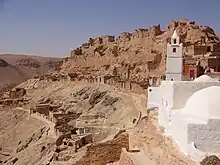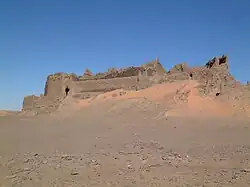Ksar
Ksar or qsar (Maghrebi Arabic: قصر qṣer or ڭصر gser, plural qṣur; Berber: ⵉⴴⵔⵎ aghrem or ighrem, plural: igherman), plural ksars, qsars, ksour or qsour, is a type of fortified village in North Africa, usually found in the regions predominantly or traditionally inhabited by Berbers (Amazigh people).[1][2]
.jpg.webp)
Related terms
The origin of the Maghrebi Arabic term qsar is qaṣar (قَصَر) in Standard Arabic, which means "castle" or "palace".[3] It was probably loaned from Latin castrum.[1] The Berber (Amazigh) word for "ksar" used in North Africa by the Berber-speaking populations is ighrem (singular) or igherman (plural), denoting a "fortified village," or "fort".[1]
Architecture

Ksour in the Maghreb typically consist of attached houses, often having collective granaries known as a ghorfa or agadir and other structures like a mosque, bath, oven, and shops. Ksour / igherman are widespread among the oasis populations of North Africa. Ksars are sometimes situated in mountain locations to make defense easier; they often are entirely within a single, continuous wall. The building material of the entire structure is normally adobe, or cut stone and adobe. The idea of the ksar as a granary is a confused notion of two things, the granary itself, found within a ksar, and the ksar, which is a village, normally with granaries within it. Ksars form one of the main manifestations of Berber architecture.
Places named Ksar
The word is part of place names across Morocco, Algeria, and Tunisia.
- Ksar Hadada, Tunisia
- Ksar Halloof, Tunisia.
- Ksar Oulad Dabab, Tunisia.
- Ksar es-Seghir, Morocco
- Ksar el-Kebir, Morocco
- Ksar Nalut, Libya
- Ksar Ouled Soltane, Tunisia
References
- Van Staëvel, J.-P. (2004). "Ḳaṣr". In Bearman, P. J.; Bianquis, Th.; Bosworth, C. E.; van Donzel, E. & Heinrichs, W. P. (eds.). Encyclopaedia of Islam. Volume XII: Supplement (2nd ed.). Leiden: E. J. Brill. ISBN 978-90-04-13974-9.
- Golvin, Lucien (1989). "Architecture berbère". Encyclopédie berbère. Retrieved 11 September 2023.
- Wehr, Hans; Cowan, J. M. A Dictionary of Modern Written Arabic (Third ed.). Ithaca, N.Y.: Spoken Language Services. p. 768.
- Binous, Jamila; Baklouti, Naceur; Ben Tanfous, Aziza; Bouteraa, Kadri; Rammah, Mourad; Zouari, Ali (2010). "X.6 Chénini (of Tataouine)". Ifriqiya: Thirteen Centuries of Art and Architecture in Tunisia. Islamic Art in the Mediterranean (2nd ed.). Museum With No Frontiers & Ministry of Culture, the National Institute of Heritage, Tunis. p. 269. ISBN 9783902782199.
External links
- www.ksour-tunisiens.com – complete documentation of all ksour of southern Tunisia, Herbert Popp & Abdelfettah Kassah

